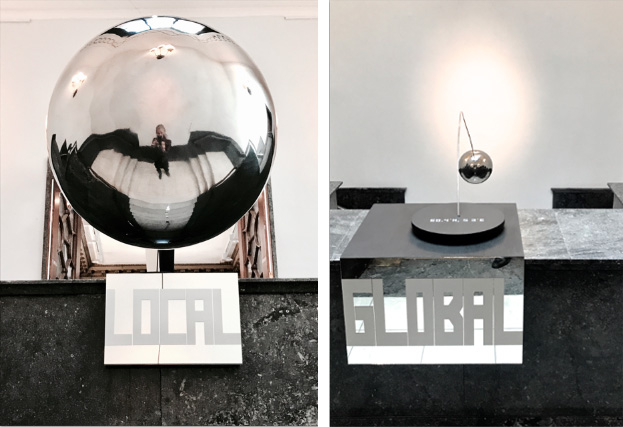Holotopia
Holotopia
Imagine...
You are about to board a bus for a long night ride, when you notice two flimsy, flickering streaks of light emanating from two wax candles, placed in the circular holes where the headlights of the bus are expected to be. Candles? As headlights? You rub your eyes in disbelief. What sort of nonsense is this? A weird joke? An art project?
Well of course, the idea of candles as headlights is absurd. So why talk about it? The reason is that, as we shall see, on a much larger scale—where the things such as our society, and the way we handle information, are so large that we cannot see them with naked eye—this absurdity has become reality.
By depicting our technologically advanced and fast-moving society as a bus, and the way we handle information as a pair of candle headlights, the Modernity ideogram renders our contemporary situation in a nutshell.
Our proposal
The crux of our knowledge federation proposal, which is detailed on this website, is to change the relationship we have with information.
What is our relationship with information presently like? Here is how Neil Postman described it:
"The tie between information and action has been severed. Information is now a commodity that can be bought and sold, or used as a form of entertainment, or worn like a garment to enhance one's status. It comes indiscriminately, directed at no one in particular, disconnected from usefulness; we are glutted with information, drowning in information, have no control over it, don't know what to do with it."
Suppose we handled information as we normally handle man-made thing—by suiting it to the purposes that need to be served. What consequences would this have? How would information be different? How would it be used? By what methods, what social processes, and by whom would it be created? What new information formats would emerge, and supplement or replace the traditional books and articles? How would information technology be adapted? What would public informing be like? And academic communication, and education?
The substance of our knowledge federation proposal is a complete and academically coherent answer to those and other related questions; an answer that is not only described and explained, but also implemented—as a collection of real-life embedded prototypes.
Seeing things whole
The Information ideogram, shown on the right, explains how the information we are proposing is different from the one we have.
The ideogram shows an "i", which stands for "information", as composed of a circle placed on top of a square. The square stands for the details; and also for looking at a theme of choice from all sides, by using diverse kinds of sources and resources. The circle stands for the function or the point of it all—which might be an insight into the nature of a situation; or a rule of thumb, pointing to a general way to handle situations of that kind; or a project, which implements such handling.

BottomUp - TopDown intervention tool for shifting positions
The BottomUp - TopDown intervention tool for shifting positions, shown above, suggests how information is to be used—by transcending fixed relations between top and bottom, and building awareness of the benefits of multiple points of view; and moving in-between.
We call the various practices that are needed for implementing our proposal knowledge federation.
Political federation brings smaller units together, to give them higher visibility and impact. Knowledge federation does that to information. Its purpose is to turn disparate "pieces of information" into effective information (the information that fulfills core purposes; which gives us the knowledge we need); and to restore knowledge to power.
We here refer to the proposed 'lightbulb' by the pseudonym holoscope, to highlight its distinguishing characteristic— that it helps us see things whole.
The holoscope uses suitable information in a suitable way, to illuminate what remained obscure or hidden, so that we may correctly see the shape and the dimensions of the whole (correct our perspective).
The holoscope complements the usual approach in the sciences:
Science gave us new ways to look at the world. The telescope and the microscope enabled us to see the things too distant or too small to be seen by the naked eye, and our vision expanded. But science also had the tendency to keep us focused on things that were either too distant or too small to be relevant—compared to all those large things nearby, which now demand our attention. The holoscope is conceived as a way to look at the world that helps us see any chosen thing or theme as a whole—from all sides; and in correct proportions.
We use the holoscope when we use the information to see things whole. We depend on information to be able to do that. We cannot see with our own eyes that the Earth is round. Our planet is too large. But someone's living on the other side. Someone's traveled around the whole thing. Someone else has traveled to the outer space. When we put all those pieces together, with a bit of reflection, we can see things whole just as clearly as when we see them with our own eyes.
We can even correct the way we see things with our eyes.




